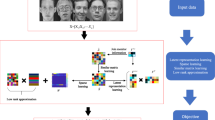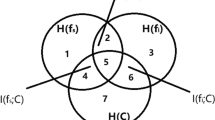Abstract
Due to the rich and comprehensive information of multiview data, multi-view learning has been attracted widely attention. Efficiently exploiting multiview data to select discriminative features to improve classification performance is very important in multi-view learning. Most existing supervised methods learn an entire projection matrix by concatenating multiple views into a long vector, thus they often ignore the relationship between views. To solve this problem, in this paper, we propose a novel sparse robust multiview feature selection model, which simultaneously considers the robustness, individuality and commonality of views via adaptive-weighting strategy. The model adopts the soft capped-norm loss to calculate the residual in each view to effectively reduce the impact of noises and outliers. Moreover, the model employs the adaptive-weighting strategy to show the individuality and commonality of views without introducing extra parameters. In addition, it introduces structured sparsity regularization to select the discriminative features. An efficient iterative algorithm is proposed to individually learn each block of the projection matrix with low computational complexity, and the convergence of the proposed optimization algorithm is verified theoretically and experimentally. The comparative experiments are conducted on multiview datasets with several state-of-the-art algorithms, and the experimental results show that the proposed method gets better performance than the others.







Similar content being viewed by others
References
Zhang R, Nie FP, Li XL (2018) Self-weighted supervised discriminative feature selection. IEEE Trans Neural Netw Learn Syst 29(8):3913–3918
Lin Q, Xue Y, Wen J, Zhong P (2019) A sharing multi-view feature selection method via alternating direction method of multipliers. Neurocomputing 333:124–134
Sechidis K, Brown G (2018) Simple strategies for semi-supervised feature selection. Mach Learn 107(2):357–395
Sheikhpour R, Sarram MA, Gharaghani S, Chahooki MAZ (2020) A robust graph-based semi-supervised sparse feature selection method. Inf Sci 531:13–30
Wang A, Wang H (2017) Unsupervised feature selection via low-rank approximation and structure learning. Knowl Based Syst 124:70–79
Liaghat S, Mansoori EG (2019) Filter-based unsupervised feature selection using Hilbert-Schmidt independence criterion. Int J Mach Learn Cybern 10(9):2313–2328
Dalal N, Triggs B (2005) Histograms of oriented gradients for human detection. Proc IEEE Comput Soc Conf Comput Vision Pattern Recognit 1:886–893
Ojala T, Pietikinen M, Menpa T (2002) Multiresolution gray scale and rotation invariant texture classification with local binary patterns. IEEE Trans Pattern Anal Mach Intell 24(7):971–987
Lowe DG (2004) Distinctive image features from scale-invariant keypoints. Int J Comput Vis 60(2):91–110
Oliva A, Torralba A (2001) Modeling the shape of the scene: a holistic representation of the spatial envelope. Int J Comput Vis 42(3):145–175
Zhao J, Xie X, Xu X, Sun S (2017) Multi-view learning overview: percent progress and new challenges. Inf Fusion 38:43–54
Peng J, Luo P, Guan Z, Fan J (2019) Graph-regularized multi-view semantic subspace learning. Int J Mach Learn Cybern 10(5):879–895
Tan B, Zhong EH, Xiang EW, Yang Q (2014) Multi-transfer: transfer learning with multiple views and multiple sources. Stat Anal Data Min 7:282–293
Zhang N, Ding S, Sun T, Liao H, Wang L, Shi Z (2020) Multi-view RBM with posterior consistency and domain adaptation. Inf Sci 516:142–157
Cheng X, Zhu Y, Song J, Wen G, He W (2017) A novel low-rank hypergraph feature selection for multi-view classification. Neurocomputing 253:115–121
Yang M, Cheng D, Nie F (2019) Adaptive-weighting discriminative regression for multi-view classification. Pattern Recognit 88:236–245
Tao H, Hou C, Yi D, Zhu J (2020) Multiview classification with cohesion and diversity. IEEE Trans Cybern 50(5):2124–2137
Wang H, Nie F, Huang H (2013) Multi-view clustering and feature learning via structured sparsity. In: Proceedings of the international conference on machine learning, pp 352–360. http://proceedings.mlr.press/v28/wang13c.html
Huang S, Zhao K, Xu Z (2018) Self-weighted multi-view clustering with soft capped norm. Knowl Based Syst 158:1–8
Sun S, Xie X, Yang M (2016) Multiview uncorrelated discriminant analysis. IEEE Trans Cybern 46(12):3272–3284
Kan M, Shan S, Zhang H, Lao S, Chen X (2016) Multi-view discriminant analysis. IEEE Trans Pattern Anal Mach Intell 38(1):188–194
Mei X, Hong Z, Prokhorov DV, Tao D (2015) Robust multitask multiview tracking in videos. IEEE Trans Neural Netw Learn Syst 26:2874–2890
Zhu X, Li X, Zhang S (2016) Block-row sparse multiview multilabel learning for image classification. IEEE Trans Cybern 46(2):450–461
Yang W, Gao Y, Shi Y, Cao L (2015) MRM-Lasso: a sparse multiview feature selection method via low-rank analysis. IEEE Trans Neural Netw Learn Syst 26(11):2801–2815
Li Y, Shi X, Du C, Liu Y, Wen Y (2016) Manifold regularized multi-view feature selection for social image annotation. Neurocomputing 204:135–141
Cong Y, Wang S, Liu J, Cao J, Yang Y, Luo J (2015) Deep sparse feature selection for computer aided endoscopy diagnosis. Pattern Recognit 48(3):907–917
Wang H, Nie F, Huang H, Risacher SL, Saykin AJ (2012) Identifying disease sensitive and quantitative trait-relevant biomarkers from multidimensional heterogeneous imaging genetics data via sparse multimodal multitask learning. Bioinformatics 28(12):I127–I136
Wang H, Nie F, Huang H, Ding C (2013) Heterogeneous visual features fusion via sparse multimodal machine. In: Proceedings of the IEEE conference on computer vision and pattern recognition, pp 3097–3102. https://doi.org/10.1109/CVPR.2013.398
Wang H, Nie F, Huang H, Kim S, Nho K (2012) Identifying quantitative trait loci via group-sparse multitask regression and feature selection: an imaging genetics study of the ADNI cohort. Bioinformatics 28(2):229–237
Zhang Q, Tian Y, Yang Y, Pan C (2014) Automatic spatial-spectral feature selection for hyperspectral image via discriminative sparse multimodal learning. IEEE Trans Geosci Remote Sens 53(1):261–279
Wang N, Xue Y, Lin Q, Zhong P (2019) Structured sparse multi-view feature selection based on weighted hinge loss. Multimedia Tools Appl 78(11):15455–15481
Shi C, Duan C, Gu Z, Tian Q, An G, Zhao R (2019) Semi-supervised feature selection analysis with structured multi-view sparse regularization. Neurocomputing 30:412–424
Zhong J, Wang N, Lin Q, Zhong P (2019) Weighted feature selection via discriminative sparse multi-view learning. Knowl Based Syst 178:132–148
Wangila K, Gao K, Zhu P, Hu Q, Zhang C (2017) Mixed sparsity regularized multi-view unsupervised feature selection. In: Proceedings of the international conference on image processing, pp 1930–1934. https://doi.org/10.1109/ICIP.2017.8296618
Nie F, Li J, Li X (2017) Convex multiview semi-supervised classification. IEEE Trans Image Process 26(12):5718–5729
Nie F, Huang H, Cai X, Ding C (2010) Efficient and robust feature selection via joint L2,1-norms minimization. In: Proceedings of the 24th Annual conference on neural information processing systems, pp 1813–1821. https://proceedings.neurips.cc/paper/2010/hash/09c6c3783b4a70054da74f2538ed47c6-Abstract.html
Cai X, Nie F, Heng H (2013) Exact top-k feature selection via l2,0-norm constraint. In: Proceedings of the 23rd international joint conference on artificial intelligence, pp. 1240–1246. http://www.aaai.org/ocs/index.php/IJCAI/IJCAI13/paper/view/6975
Wang F, Rao Q, Zhang Y, Chen X (2016) Robust sparse subspace learning for unsupervised feature selection. In: Proceedings of the international joint conference on neural networks, pp 4205–4212. https://doi.org/10.1109/IJCNN.2016.7727748
Du S, Ma Y, Li S, Ma Y (2017) Robust unsupervised feature selection via matrix factorization. Neurocomputing 241:115–127
Tang C, Liu X, Li M, Wang P, Chen J, Wang L, Li W (2018) Robust unsupervised feature selection via dual self-representation and manifold regularization. Knowl Based Syst 145:109–120
Gao H, Nie F, Cai W, Huang H (2015) Robust capped norm nonnegative matrix factorization. In: Proceedings of the 24th ACM international conference on information and knowledge management, pp 871–880. https://doi.org/10.1145/2806416.2806568
Lan G, Hou C, Yi D (2016) Robust feature selection via simultaneous capped l2-norm and l2,1-norm minimization. In: Proceedings of the 2016 IEEE international conference on big data analysis, pp 1–5. https://doi.org/10.1109/ICBDA.2016.7509813
Lan G, Hou C, Nie F, Luo T, Yi D (2018) Robust feature selection via simultaneous capped norm and sparse regularizer minimization. Neurocomputing 283:228–240
Wang H, Nie F, Huang H, Risacher S, Ding C (2011) Sparse multi-task regression and feature selection to identify brain imaging predictors for memory performance. In: Proceedings of the IEEE international conference on computer vision, pp 557–562. https://doi.org/10.1109/ICCV.2011.6126288
Author information
Authors and Affiliations
Corresponding author
Additional information
Publisher's Note
Springer Nature remains neutral with regard to jurisdictional claims in published maps and institutional affiliations.
Rights and permissions
About this article
Cite this article
Wang, Z., Zhong, J., Chen, Y. et al. Sparse robust multiview feature selection via adaptive-weighting strategy. Int. J. Mach. Learn. & Cyber. 13, 1387–1408 (2022). https://doi.org/10.1007/s13042-021-01453-y
Received:
Accepted:
Published:
Issue Date:
DOI: https://doi.org/10.1007/s13042-021-01453-y




